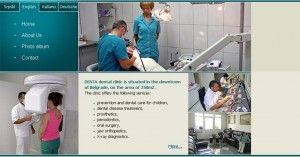According to the 1990 US Census Bureau, 31.8 million residents, or 14% of the population 5 years old and older, reported speaking a language other than English at home. The most common non-English language spoken at home was Spanish (17.3 million) followed by French (1.9 million), German (1.5 million), Chinese (1.3 million), and Italian (1.3 million). Seven states—New Mexico, California, Texas, Hawaii, New York, Arizona, and New Jersey— reported that 20% or more of their residents did not speak English at home.
Clear communication between the dentist and patient is an obvious requisite for effective health care delivery, but how is this best accomplished when English is not the common language? While it may seem that the most logical solution would be to use interpreters whenever possible, many dental hospitals and clinics do not employ professional interpreters. Also, existing interpreters may be underused if dentist and nurses overestimate their own language skills or those of the patient. Some dentists may simply be uncomfortable with the potential for information distortion that can occur through an interpreter.
Another common approach to communicating with patients who do not speak English is to use ad hoc interpreters such as family members, friends, or dental hospital employees. While this may be convenient, the interpretations may not always be accurate. One study3 showed that between 23% to 52% of words and phrases were incorrectly translated by ad hoc interpreters. A drawback to letting family members interpret is that one sacrifices patient confidentiality. Cultural mores may lead non–English-speaking patients to withhold more information than one might otherwise expect. Friends and family often are not prepared to deal with the complexity required by an interpretation of dental information.
Perhaps the ideal solution to establishing clear channels of communication between dentists and patients would be to recruit multilingual medical personnel in hospitals serving large non–English-speaking populations. The multilingual dentist can immediately evaluate a non–English speaking patient without having to seek out and wait for an appropriate interpreter to arrive, and the fear of mistranslation or shades of meaning being misinterpreted would be removed. Studies have shown that language concordance also leads to increased patient adherence.
Keep in mind that traditional modes of communication, which may be the most readily available, are not the only option. Patient education audiotapes exist in various languages. Also, AT&T has a toll-free Language Line Service, that will connect you with an interpreter in the language of your choice (with up to 140 different languages) 24 hours a day, 7 days a week. Lastly, there has been some movement toward the use of “remote-simultaneous interpretation,†which uses cellular phone technology to link trained interpreters to the people who need them most.
Encounters with non–English-speaking patients are common, especially in metropolitan areas with large immigrant populations. With increased recognition of the difficulties posed by multilingualism as well as the growing number of solutions, we can hope that the treatment of non– English-speaking patients will become less problematic as we enter the 21st century.
Strategies for Communicating With Non–English-Speaking Patients
- Unless you are thoroughly proficient and fluent in the target language, always use an interpreter.
- When using an interpreter, address your patients directly, rather than speaking mostly to the interpreter, and allow extra time for the interview.
- When speaking directly to the patient without an interpreter, speak slowly and carefully, without jargon or idioms and without raising your voice. Recognize that people wrongly think that turning up the volume somehow creates instant understanding. Avoid this common mistake (however, do not speak too quietly).
- Do not use baby talk or incorrect English. This does not make you easier to understand. It will confuse your listener and may give the wrong impression about your own level of competence.
- Do not cover or hide your mouth because listeners will want to watch you as you pronounce your words. This helps them figure out what you are saying in many cases.
- Avoid running words together ( Do-ya wanna eat-a-pizza?). One of the biggest challenges for listeners is knowing where one word ends and the next one begins. Give them a small pause between words if they seem to be struggling.
- Repeat when you have not been understood. If something has been said as simply as possible and is still not understood, try repeating the same sentence again; changing words may confuse the patient.
- When possible, opt for simple words instead of ones that are complex. The more basic a word is, the better the chance is that it will be understood. (“Big” is a better choice than “enormous” for example. “Make” is a better choice than “manufacture.”) However, with a Romance language speaker (i.e. Spanish, French, Italian, Portuguese, Romanian), these ‘complex’ words can be useful as they are rooted in Latin.
- Check that you have been understood. Avoid asking questions such as “Do you understand?†or “Is that all right?†as these are likely to be answered by a “yes†whether or not the patient has understood.
- When encountering difficulties communicating, try using multilingual patient education materials, illustrations, or models.


